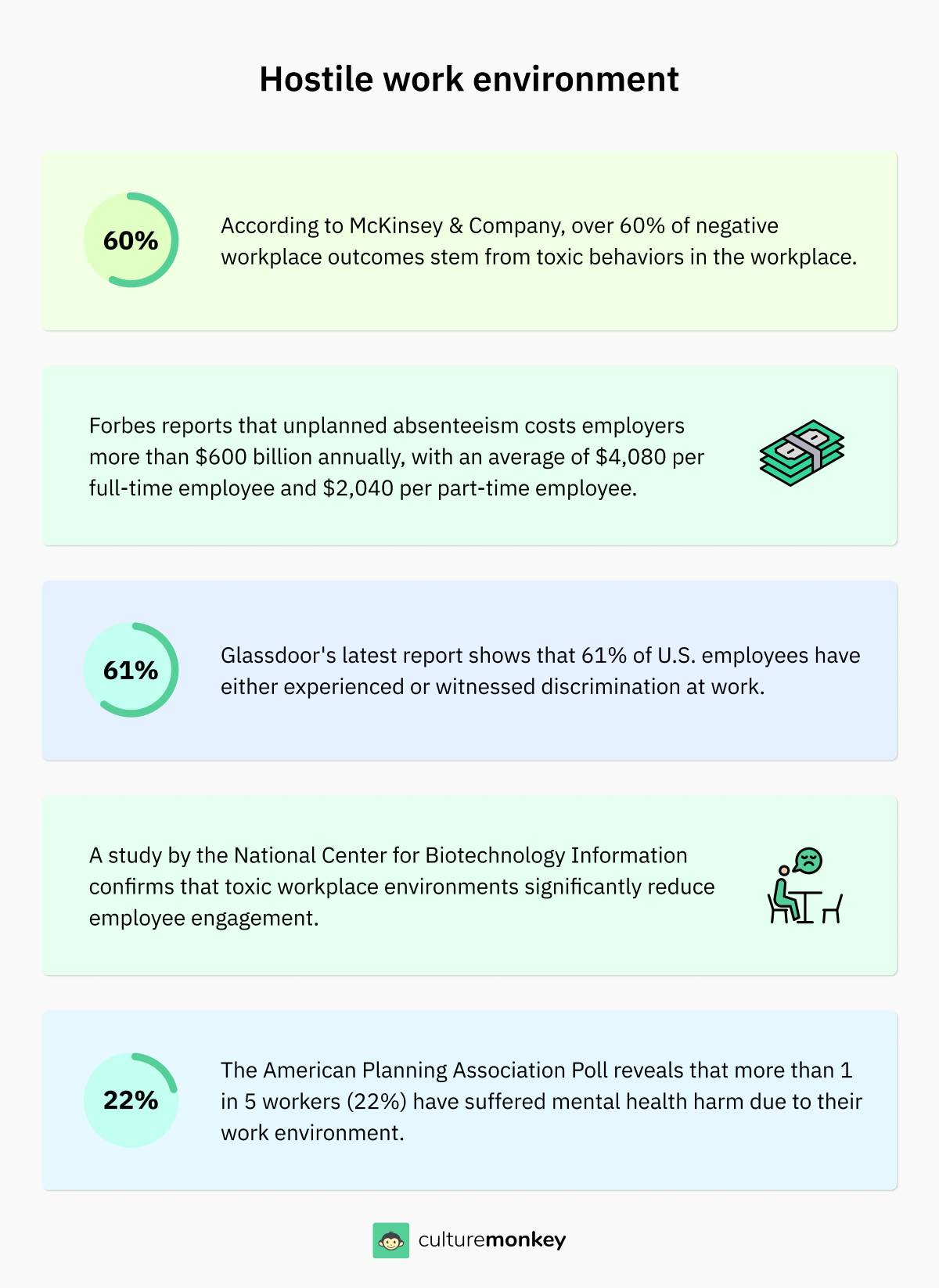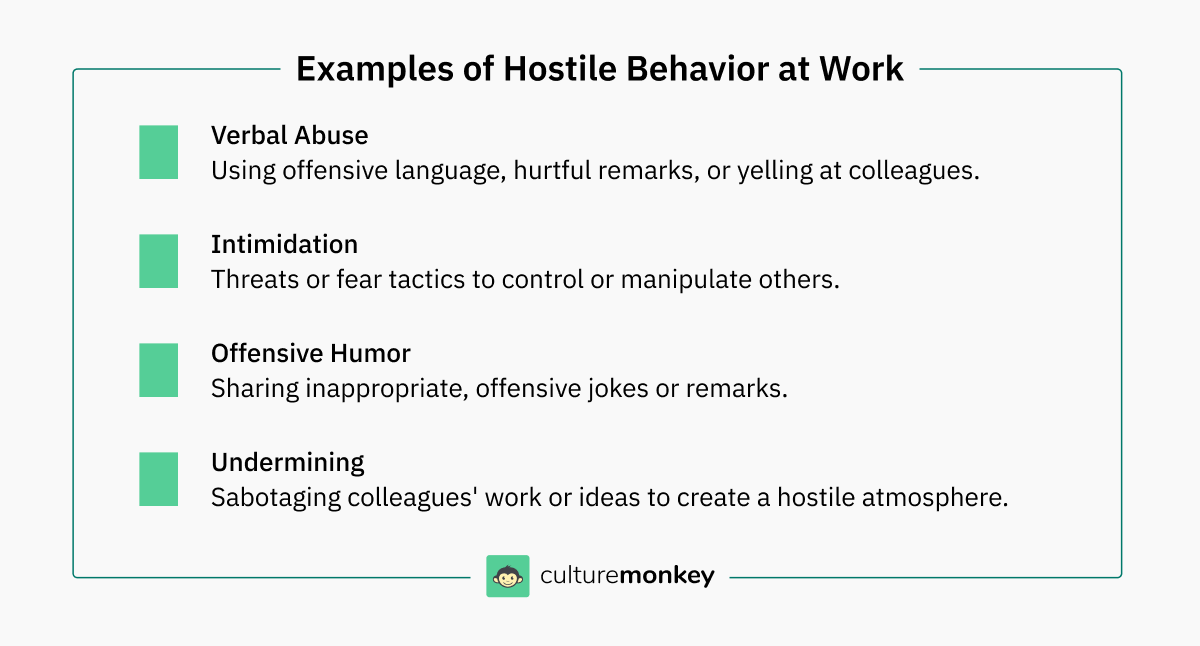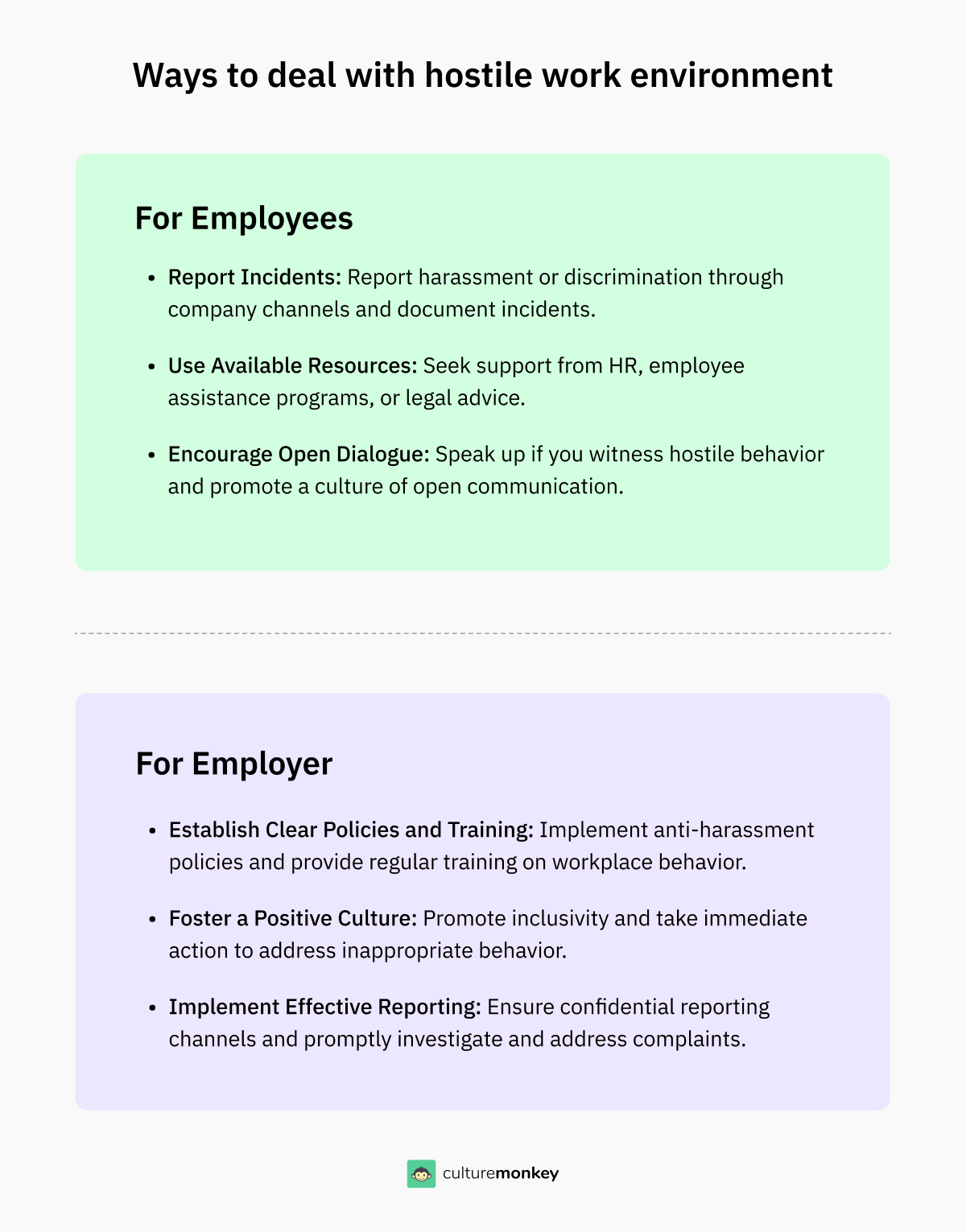Hostile work environment: Strategies to reduce conflict and foster safety in 2026

Ever been in a long group chat where one person dominates every conversation, another stops replying altogether, and everyone else just reacts with emojis to keep the peace? No one argues, but the tension is obvious. That’s how hostility begins, quietly, through discomfort that no one names.
Workplaces often mirror that same energy. A few unchecked comments, favoritism disguised as “banter,” or dismissive jokes start building walls between people who once collaborated freely. Over time, silence becomes the safer option than speaking up. Recognizing those subtle shifts early isn’t about overreacting, it’s about preserving trust before discomfort turns into disengagement.
- A hostile work environment arises from harassment, discrimination, or intimidation tied to protected traits.
- Routine stress, disputes, or discipline don’t meet EEOC hostile work environment definition.
- Examples include bullying, gaslighting, scapegoating, verbal abuse, and public humiliation..
- Employer mistakes: ignoring complaints, delays, weak enforcement, lack of support.
- Prevention needs clear standards, safety, training, support, and swift action.
What is a hostile work environment?
A hostile work environment is like walking into a meeting where everyone looks calm, but no one dares to speak honestly. Beneath polite smiles lies unease, built from repeated slights, offhand jokes, or subtle favoritism that people learn to tiptoe around. Over time, that tension becomes part of the workplace atmosphere, eroding trust and comfort.
A hostile work environment exists when repeated harassment, discrimination, or intimidation based on protected traits creates fear, stress, or discomfort.
It goes beyond workplace conflict, meeting EEOC hostile work environment standards and directly harming employee well-being, trust, and productivity.
It usually starts small. Repeated comments, exclusion, or targeted behavior toward someone because of gender, race, age, or disability can evolve into hostile work environment harassment. When this treatment becomes severe or pervasive enough to affect daily work, it meets the legal hostile work environment definition. Even retaliation or unequal workload discrimination after someone reports issues can constitute hostile work environment behavior.
The real damage comes when leaders ignore warning signs. Bullying, intimidation, or public shaming create an uncomfortable work environment that drains confidence and morale. And when management overlooks complaints or fails to act, that silence validates the hostility, showing employees that their safety and respect are optional, not protected.
Now that we’ve defined hostility, it’s equally important to clear up the common misunderstandings around it. Not every disagreement or tough boss qualifies. Separating myths from facts helps leaders respond to the real warning signs instead of overreacting to routine friction.
Myths vs facts: What is not considered a hostile work environment?

Not every disagreement or tough day at work points to hostility. Teams argue, deadlines get stressful, and feedback can sting, that’s part of how workplaces function.
The key is knowing where healthy tension ends and harmful behavior begins. Understanding this difference helps leaders act before normal friction crosses into a truly hostile work environment.
Understanding what doesn’t count as hostility brings us to what prevents it, psychological safety. It’s the invisible guardrail that keeps discomfort from turning into disengagement. When people feel safe to speak up, teams thrive and hostility loses its power to take root.
Why is psychological safety important in the workplace?
In workplaces, psychological safety cushions people from fear, blame, and silence, allowing them to speak up, share ideas, and recover from mistakes without judgment.
- Boosts open communication: In psychologically safe environments, employees speak honestly without fear of backlash—something you rarely see in coworker hostile work environment situations where silence becomes survival.
- Reduces turnover and burnout: Teams with high psychological safety report lower stress and attrition, unlike those facing ongoing hostile work environment examples like bullying, gaslighting, or exclusion.
- Encourages innovation and risk-taking: When people aren’t worried about ridicule, they take smart risks. In contrast, one of the examples of hostile work environment is punishing failure, which kills creativity.
(Source: NCI)
- Strengthens team trust: Teams thrive when members feel protected—not targeted. Trust is the opposite of what constitutes a hostile work environment, where fear and favoritism rule.
- Helps identify issues early: A safe space lets employees raise red flags before situations escalate into one of the three types of hostile work environment defined by law. Knowing how to survive a hostile work environment often means focusing on self-care, seeking allies, and planning long-term solutions while addressing immediate concerns.
- Supports personal growth: Knowing how to deal with a hostile work environment starts with prevention. Safety allows people to grow, while learning how to handle a hostile work environment or how to survive in a hostile work environment should be the last resort—not the norm.
Psychological safety sets the tone for awareness, but recognition is the next step. Hostility often hides behind jokes, silence, or “just feedback.”
Spotting when discomfort becomes toxic helps leaders intervene early and prevent small issues from snowballing into systemic problems.
What is considered a hostile work environment?

A hostile work environment doesn’t appear overnight. It builds slowly, through repeated disrespect, unchecked bias, or intimidation that starts to feel normal. Over time, what should be collaboration turns into quiet survival, where employees focus on getting through the day instead of doing their best work.
A hostile work environment exists when harassment, bullying, or discrimination based on protected traits becomes severe or persistent enough to disrupt work. Behaviors like intimidation, offensive humor, retaliation, or gaslighting cross the line, meeting EEOC hostile work environment standards and creating fear, stress, and reduced productivity for employees.
- Harassment and discrimination: Persistent, unwelcome comments or actions related to protected characteristics like race, gender, or age.
- Intimidation and threats: Bullying or aggressive behavior that creates fear or unease.
- Offensive behavior: Derogatory language, gestures, or actions targeting individuals or groups.
- Isolation and exclusion: Deliberate exclusion from work activities based on protected characteristics in isolated incidents.
- Retaliation: Negative consequences for reporting harassment or discrimination.
- Pervasive negativity: A hostile atmosphere that affects the overall work environment.
- Unaddressed complaints: Failure to address employee concerns about the environment.
- Impact on performance: Decreased productivity due to the hostile atmosphere.
- High turnover: Frequent departures, especially from specific groups.
- Subtle microaggressions: Indirect acts of bias, like backhanded compliments.
- Cliquish behavior: Exclusive groups that marginalize others.
- Inconsistent policy enforcement: Unequal application of harassment or discrimination policies.
- Health effects: Emotional or physical health impacts like stress and anxiety.
- Excessive workload: Unfair workload targeting individuals based on protected characteristics.
- Undermining achievements: Efforts to downplay the accomplishments of certain groups.
- Unjustified scrutiny: Unfair criticism of work based on protected characteristics.
- Favoritism: Preferential treatment based on personal relationships, not merit.
- Emotional manipulation: Gaslighting, guilt-tripping, or other forms of psychological coercion that make employees doubt their own experiences.
Even when hostility is clear, it’s often mistaken for discrimination, and vice versa. The two overlap but aren’t identical. Understanding where they diverge helps HR teams handle complaints correctly, protect fairness, and ensure both employees and employers are fully compliant.
What is the difference between a hostile work environment and workplace discrimination?
A hostile work environment and workplace discrimination often overlap, but they aren’t the same. One is about repeated behavior that creates fear or discomfort, while the other involves unfair treatment tied to identity or status.
Understanding this distinction helps organizations respond with the right policies and accountability.
So once we understand how hostility differs from discrimination, the next question is: what real impact does a hostile work environment have, and what do the numbers reveal?
What is the impact of a hostile work environment on employees and business?

A hostile work environment doesn’t just harm individuals, it weakens the entire organization. When negative behavior goes unchecked, it lowers morale, slows collaboration, and drives high-performing employees away. Over time, it impacts productivity, retention, and the overall health of the company culture.
- Toxic behavior costs: According to Hogan Assessments, toxic employees cost U.S. businesses about $292 billion annually, draining productivity through aggression, manipulation, and workplace hostility.
- Productivity decline: Pollack Peacebuilding reports that disengaged or stressed employees in hostile environments cost organizations $450–550 billion per year in lost productivity and absenteeism.
- Job insecurity stress: APA's 2025 Work in America survey found that 54% of U.S. workers say job insecurity significantly impacts their stress levels.
- Leadership and toxicity: According to iHire’s 2025 report, 78.7% of employees who have experienced a toxic workplace cite poor leadership or unsupportive management as the top cause.
- Rising confrontational behavior: A recent survey by Investopedia found that 30% of job-seeking Americans say coworkers have become more confrontational over the past three years, signaling increasing workplace hostility.
Seeing the impact makes one thing clear, hostility doesn’t look the same everywhere. Some versions are loud and obvious; others are subtle and systematic. Breaking down the seven types helps leaders recognize hidden forms of toxicity before they spread deeper into culture.
What are the 7 types of hostile work environments?

Hostile work environments are like weeds in a garden, each looks different, but all thrive when left unchecked. Some are loud and visible, others grow quietly under the surface.
Knowing the different types helps leaders spot early signs of toxicity before they overrun the culture completely.
The 7 types of hostile work environments are sexual harassment, discriminatory actions, bullying, retaliation, intimidation, toxic leadership, and exclusion. Each erodes trust and well-being at work.
These behaviors meet EEOC hostile work environment standards when persistent, creating fear, stress, and disengagement beyond normal workplace conflict.
- Discriminatory hostile work environment: This type involves offensive behavior or exclusion based on protected characteristics like race, gender, or age. According to the definition of a hostile work environment, this includes slurs, jokes, or biased policies that create a demeaning atmosphere.
- Sexual hostile work environment: Unwanted sexual advances, suggestive comments, or explicit content at work may define what is a hostile work environment under sexual harassment laws. These actions interfere with job performance and create emotional distress.
- Bullying or intimidation-based hostility: Verbal abuse, threats, or aggressive behavior from colleagues or supervisors can form a toxic culture. Even without discriminatory intent, this hostile environment meaning affects mental health and productivity.
- Retaliation-based hostile environment: When employees face backlash—such as isolation or demotion—after reporting issues or joining investigations, it constitutes a hostile work environment by creating fear and silence in the workplace.
- Microaggressions and subtle bias: Dismissive comments, patronizing tones, or exclusion from key decisions may not seem extreme but erode trust over time. This type of behavior fits the modern definition of a hostile work environment rooted in ongoing psychological harm.
- Disparate treatment and favoritism: Unequal access to promotions, biased performance reviews, or preferential treatment based on identity can signal a systemic hostile work environment—especially when tied to protected traits.
- Cultural exclusion and marginalization: Workplaces that ignore or devalue cultural norms, languages, or customs of certain employees create invisible barriers. This subtle form of toxicity falls under what constitutes a hostile work environment in diverse teams.
Knowing the types sets the stage for specifics. Real-world examples make these patterns easier to recognize. When teams can identify hostile behavior as it happens, they gain the power to call it out, document it, and take the right corrective action.
What are examples of a hostile work environment?

Examples of a hostile work environment often start subtly. A dismissive comment here, an unfair workload there, small signs that something isn’t right.
When these behaviors repeat or go unaddressed, they form patterns of disrespect and exclusion that lead to stress, disengagement, and burnout.
- Verbal abuse: Offensive language, insults, or yelling at colleagues can create an intimidating work environment and damage morale , signaling hostile work environment harassment.
- Intimidation: Using threats or fear tactics to pressure employees is a clear form of hostility in the workplace. This often leads to anxiety and reduced performance.
- Offensive humor: Inappropriate jokes or remarks targeting protected groups aren’t harmless—they’re hostile work environment bullying examples that reinforce stereotypes and exclusion.
- Undermining: Sabotaging projects or dismissing ideas is what constitutes a hostile work environment, especially when done to weaken a colleague’s credibility.
- Gaslighting: Manipulating employees into doubting themselves is hostile environment harassment. It causes confusion, erodes trust, and meets hostile work environment definition standards.
- Public humiliation: Embarrassing employees in front of peers creates a toxic work environment red flag and discourages open communication.
- Excessive micromanagement: Over-control of tasks to the point of stifling creativity is considered hostile work environment bullying in many workplaces.
- Scapegoating: Blaming individuals unfairly fosters hostility in the workplace, often leading to hostile work environment retaliation or lawsuits.
Once the warning signs are clear, the next question becomes, what legal protections exist? Employees shouldn’t have to guess whether their safety is protected. Understanding workplace laws helps both workers and employers prevent missteps that could lead to legal or cultural fallout.
What laws protect employees from a hostile work environment?

Laws that protect employees from workplace hostility set clear boundaries for what’s acceptable at work. They outline what qualifies as a hostile work environment and ensure accountability when harassment, bias, or intimidation crosses into unlawful behavior, helping organizations maintain fairness and safety for all employees.
- Title VII of the Civil Rights Act: This foundational law prohibits workplace harassment and discrimination based on race, gender, religion, color, or national origin. When hostile workplace behavior targets these protected traits, it meets the legal definition of hostile work environment under the EEOC.
- Americans with Disabilities Act (ADA): The ADA protects employees with physical or mental conditions from exclusion or ridicule. Persistent jokes, isolation, or other hostile behavior at work tied to disability transform workplace conflicts into legally recognized signs of a hostile work environment.
- Age Discrimination in Employment Act (ADEA): Employees aged 40 and above are protected from unfair treatment, demotion, or bias. When managers mock age, assign demeaning tasks, or foster workplace intimidation, it’s considered bullying in the workplace and a form of workplace harassment and discrimination.
(Source: SCLG)
- Occupational Safety and Health Act (OSHA): Beyond physical safety, OSHA safeguards emotional safety at work. Employers must prevent workplace toxicity that causes psychological stress, anxiety, or burnout, the common effects of workplace hostility on productivity and well-being.
- Equal Pay Act (EPA): The EPA prohibits pay gaps based on gender and helps curb toxic leadership at work that breeds favoritism. Unequal compensation or retaliation in hostile work environments violates this law and fosters resentment and disengagement.
- State and local laws: Many states add protections for sexual orientation, gender identity, and marital status. They expand HR policies for hostile work environments and ensure stronger accountability when employees are dealing with workplace toxicity.
- Employer responsibility: Employers must act promptly on reporting hostile work environment complaints. Ignoring examples of hostile behavior in the workplace or retaliation against whistleblowers can trigger legal action and severe reputational damage.
Even with strong laws, organizations often stumble in execution. Some act too late, others ignore early complaints, and a few rely on outdated policies. Knowing the most common mistakes helps employers build consistency, fairness, and credibility in how they address hostility.
Common mistakes employers make when addressing hostility
Addressing hostility requires more than surface-level action. Many employers focus on quick resolutions instead of uncovering the root causes. When issues like mistrust, bias, or fear go unaddressed, they quietly shape the company culture and make lasting change much harder to achieve.
- Ignoring early signs: Overlooking hostile work environment bullying examples such as verbal abuse or intimidation allows toxicity to grow until it meets hostile work environment definition standards.
- Delaying investigations: Slow responses to complaints increase risk of hostile work environment lawsuits and destroy employee trust in leadership and HR.
- Inconsistent enforcement: Applying policies unevenly leads to claims of unequal workload discrimination and creates toxic work environment red flags across teams.
- Treating policies as formality: Having anti-harassment rules without active enforcement fails EEOC hostile work environment guidelines and makes employees doubt organizational commitment.
- Neglecting employee support: Ignoring offensive behavior in the workplace without offering counseling or wellness resources deepens hostility and legally constitutes a hostile work environment under EEOC standards.
Identifying missteps is only half the journey, taking action is what creates real change. Whether you’re an employee facing conflict or a leader guiding others, here’s how both sides can handle hostility effectively and rebuild a sense of safety and trust.
How to handle a hostile work environment as an employee or employer?

Handling a hostile work environment is like putting out a slow-burning fire, you can’t ignore the smoke and hope it disappears. Whether you’re an employee feeling the heat or a leader responsible for safety, acting early, documenting clearly, and communicating openly are the only ways to stop it from spreading.
How employees can deal with hostile work environment:
- Report incidents: If you're facing harassment or discrimination, report it through your company’s established channels. Document incidents to strengthen hostile work environment cases if further action is needed.
- Use available resources: Seek support from HR, employee assistance programs, or external legal advice if necessary.
- Encourage open dialogue: Speak up if you witness hostile behavior, and encourage a culture where concerns can be raised without fear of retaliation.
- Document everything: Keep a detailed record of incidents, including dates, times, and witnesses. This documentation can strengthen your case if further action is required.
- Seek support from colleagues: Reach out to trusted coworkers for support or advice, as they may have experienced similar situations or witnessed the behavior.
- Know your rights: Educate yourself on workplace harassment laws and company policies to understand your rights and options for addressing the issue.
- Take care of your well-being: A hostile environment can impact mental health. Consider seeking professional help from a counselor or therapist to manage stress.
How employers should deal with hostile work environment:
- Establish clear policies and training: Implement comprehensive anti-harassment and anti-discrimination policies. Regular training should be conducted for all employees to raise awareness about workplace harassment, discrimination, and reporting procedures.
- Foster a positive culture: Promote teamwork, inclusivity, and respect. Encourage open communication and take immediate action to address inappropriate behavior.
- Implement effective reporting and response mechanisms: Ensure confidential and anonymous reporting channels. Investigate complaints promptly and take corrective action to prevent retaliation.
- Conduct regular assessments: Monitor the work environment through surveys, feedback sessions, and reviews to identify and address potential issues before they escalate.
- Inclusive leadership: Train managers to lead by example, promote diversity, and address conflicts constructively. Leaders set the tone for a respectful workplace.
- Establish a zero-tolerance policy: Clearly communicate that harassment, discrimination, and hostility will not be tolerated, and outline the consequences for such behavior.
- Provide ongoing training: Offer continuous diversity and inclusion training to mitigate hostile work environment, reinforcing respectful behavior and the importance of a positive work environment.
- Encourage bystander intervention: Promote a culture where employees feel empowered to step in or report hostile behavior when they witness it.
- Take immediate action on complaints: Address complaints promptly and seriously, ensuring that investigations are thorough and actions are taken to prevent future issues.
Policies are powerful, but training is what turns them into behavior. Hostile work environment training gives employees and managers the awareness, tools, and confidence to stop hostility early, before it damages culture, trust, or legal compliance in the organization.
What is hostile work environment training?
Hostile work environment training is like a safety rehearsal for culture; you run it before anything breaks in public. It teaches teams to spot early hostility, connect it to policy and law, and respond fast when behavior shifts from awkward to harmful or discriminatory toward someone on the team, not later.
People work better when they know what the goal is and why. It is important that people look forward to coming to work in the morning and enjoy working.
Here's the scoop on why it's essential:
- Legal compliance: Hostile work environment training is often legally required in many jurisdictions. Failing to provide this training can land companies in hot water with lawsuits and fines. It's not just about playing by the rules; it's about avoiding costly legal pitfalls.
- Prevention is key: Hostile work environment training is a proactive approach to prevent hostile work environments from forming in the first place. It empowers employees to recognize, report, and address issues, creating a safer workplace for all.
- Cultural transformation: Beyond compliance, hostile work environment training plays a vital role in reshaping organizational culture. It promotes respect, empathy, and understanding among employees, leading to a more positive work environment.
- Increased productivity: A harmonious workplace is a productive workplace. When employees feel safe and respected, they're more likely to be engaged, motivated, and focused on their tasks.
- Protecting reputation: In the age of social media, a company's reputation is always on the line. Hostile work environment training helps to safeguard your brand's image by demonstrating a commitment to a safe, respectful work environment.
After awareness and training, comes action. Fixing hostility isn’t a one-time project—it’s an ongoing repair process. This section walks through proven, practical steps to rebuild trust, accountability, and belonging across teams that may already feel divided or demotivated.
How to fix a hostile work environment?
Fixing a hostile work environment is like restoring a house after years of neglect, you can’t just repaint the walls; you have to rebuild the foundation. It takes honest reflection, strong leadership, and consistent action to replace fear and frustration with trust, communication, and genuine psychological safety.
Fixing a hostile work environment starts with clear communication, fair policies, and leadership accountability. Open dialogue and consistent standards help prevent toxic work environment red flags from escalating.
Employers should provide support resources, enforce anti-harassment rules, recognize contributions, and act swiftly on complaints to reduce hostility and avoid hostile work environment lawsuits.
- Establish clear communication: Open dialogue and transparency prevent frustration that can lead to hostility in the workplace.
- Set clear behavior standards: Define what constitutes a hostile work environment and enforce rules consistently.
- Train leaders effectively: Equip managers to recognize hostile work environment bullying and intervene early.
- Promote psychological safety: Ensure employees can raise concerns without fear of retaliation.
- Encourage inclusion: Team projects and mentorship reduce favoritism, a common hostile work environment example.
- Enforce anti-harassment policies: Strong policies define hostile work environment harassment and support EEOC compliance.
- Provide employee support: Wellness programs and counseling help employees cope in a hostile work environment.
- Recognize contributions: Regular recognition prevents toxic work environment red flags like disengagement.
- Monitor culture regularly: Use surveys to track issues and prove a hostile work environment isn’t forming.
- Act on complaints quickly: Addressing offensive behavior prevents escalation into hostile work environment lawsuits.
So once organizations know how to prevent workplace hostility through policies and leadership, how can an employee experience platform actively tackle hostile work environment harassment and create lasting change?
How can an employee experience platform help tackle a hostile work environment?
An employee experience platform helps leaders identify issues that often go unnoticed. By gathering honest feedback, tracking behavioral patterns, and enabling timely action, it allows organizations to detect and address workplace hostility early, creating a culture built on trust, transparency, and psychological safety.

Hostile Work Environment Survey
HRs and managers can use these surveys to detect issues, spot harassment trends, and check employee well-being.
Download Now- Data-driven insights: An EXP is like a detective gathering clues. It collects data on employee sentiments, interactions, and feedback. With this info in hand, HR can spot early signs of hostility and address issues proactively.
- Real-time feedback loops: EXPs offer employees a voice that can be heard in real-time. This empowers them to report concerns or incidents swiftly, allowing HR to intervene promptly and prevent problems from escalating.
- Training and development: Many EXPs include learning modules that can address hostile work environment issues. Employees can access resources on diversity, inclusion, and conflict resolution, helping to build a more educated and respectful workforce.
- Performance evaluation: An EXP can track individual and team performance. This data can help identify patterns of hostility, such as one team consistently underperforming due to a hostile manager, prompting intervention.
- Cultural transformation: The EXP can be a catalyst for change by promoting a culture of inclusivity and respect. It serves as a platform to communicate company values and objectives, making employees more aware of the importance of creating a welcoming workplace.
Conclusion
A hostile work environment doesn’t just damage morale, it quietly erodes trust, safety, and long-term performance. When employees feel unheard or intimidated, innovation slows, turnover rises, and even small teams start to fracture. Recognizing and addressing hostility early isn’t just an HR necessity; it’s a business imperative. Creating an environment where people feel safe to speak up, respected in every interaction, and confident that leadership will act fairly is what sustains a healthy culture.
CultureMonkey helps organizations build exactly that. Through anonymous employee feedback, real-time sentiment tracking, and actionable engagement insights, it empowers leaders to detect early signs of hostility before they escalate. By combining data with empathy,
CultureMonkey enables organizations to transform feedback into trust, helping teams feel heard, valued, and psychologically safe. Because when employees feel safe, they don’t just stay, they contribute, collaborate, and grow together.
FAQs
1. How to deal with a hostile employee?
To deal with a hostile employee, stay calm, document workplace misconduct, and address it privately first. If offensive conduct, workplace bullying, or threats appear, escalate to HR under federal law. Include dates, witnesses, and impact on job satisfaction. This also supports continued employment and proves actions against the person creating hostility.
2. What are the signs of a hostile work environment?
Hostile work environment results often show up as repeated offensive conduct, exclusion, safety violations, or harassment based on a protected class such as national origin or sexual orientation. When employees fear reporting safety concerns or notice job satisfaction dropping, the workplace creates an abusive working environment that needs investigation. Supervisors should act quickly to protect employee satisfaction and continued employment.
3. What behaviors are considered criteria for a hostile work environment?
Behaviors like sexual harassment, repeated insults, workplace bullying, intimidation, or retaliation toward someone in a protected class meet hostile standards when persistent. A reasonable person would find that harassment occurs often enough to disrupt work. Even isolated incidents can qualify as severe, threatening, or tied to tangible employment action. This is especially true for workplace sexual harassment that is ignored by management.
4. How to report a hostile work environment?
Start by documenting dates, locations, people involved, and any workplace misconduct or offensive conduct. Submit a harassment complaint through HR or the reporting channel in your policy. Federal law protects good-faith reports, especially when harassment based on national origin or sexual orientation affects safety or company’s reputation. Keep copies to show patterns and support continued employment protections if retaliation occurs.
5. How to deal with a hostile work environment?
Document every incident, set boundaries, and use internal channels early. If severe harassment or workplace bullying continues, escalate to HR, compliance, or external agencies. Addressing hostility quickly reduces safety concerns, protects job security, and shows the person creating conflict that abusive behavior will not be tolerated. This also helps preserve employee satisfaction and a healthy workplace culture while supporting continued employment.
6. How do you survive an unhealthy and hostile workplace?
Prioritize mental health, document offensive conduct, and limit exposure to the person creating conflict. Seek guidance from HR or legal if regulatory violations, safety violations, or harassment occurs. Planning an exit while staying professional protects job satisfaction and future continued employment opportunities. Lean on trusted colleagues, and report safety concerns to prevent escalation into an abusive working environment that harms employee satisfaction.
7. How can remote work affect a hostile work environment?
Hostility can appear in chats, calls, or meeting exclusions, even without physical violence. Offensive conduct, workplace sexual harassment, or bullying online still targets a protected class and hurts employee satisfaction. A reasonable person should report digital workplace misconduct quickly to protect job security and maintain a healthy workplace, and to show the workplace creates safeguards against retaliation or continued harassment.
8. What role do bystanders play in a hostile work environment?
Bystanders help prove that harassment occurs and that conduct was unwelcome. Reporting safety concerns, workplace bullying, or harassment based on national origin or sexual orientation supports the victim’s harassment complaint. Speaking up also protects the company’s reputation and discourages future abusive working environment patterns across teams. This encourages employee satisfaction and shows federal law protections can actually work when reporting is consistent.
9. What qualifies as a hostile work environment?
A workplace qualifies as hostile when harassment based on a protected class is severe or frequent enough that a reasonable person would find it disruptive. Offensive conduct, threats, or repeated insults that affect job satisfaction, employee safety, or continued employment go beyond isolated incidents and require employer action to prevent regulatory violations and protect a healthy workplace culture that supports employee satisfaction.
10. How to handle a hostile work environment?
Handling hostility means acting early, not waiting for escalation. Document every event, report through official channels, and request HR follow-up. If the person creating the issue retaliates, involve compliance. This protects job security, company’s reputation, and shows the workplace creates real accountability for misconduct, and reduces risks of tangible employment action or hostile work environment results under federal law.








